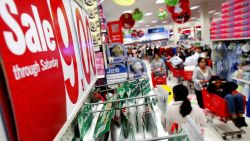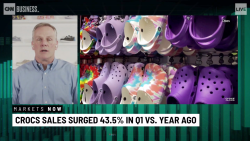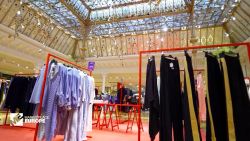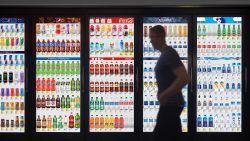Editor’s Note: Brian W. Nagel is managing director and senior analyst at Oppenheimer, covering the consumer growth and e-commerce sectors. The views expressed in this commentary are his own. Read more opinion articles on CNN.
With the holiday shopping season now upon us, it’s once again evident that no broader shift within the consumer landscape has been more significant than the transition in spending to online.

Indeed, one of the most salient components of the overall e-commerce discussion has been the future of retail stores, with many arguing that online commerce will ultimately render physical retail locations largely obsolete. Some even refer to such a dynamic as a retail apocalypse.
I disagree.
For the past couple of decades, I’ve worked on Wall Street as a stock analyst covering consumer and retail, and an expansive collection of the most recognized and powerful companies within the sectors. I have long believed that calls for the demise of retail stores are very premature, if not misplaced, and have argued that online commerce should ultimately serve to enhance legacy, consumer business models — retailers that use or are based on brick-and-mortar stores.
To be clear, online-only commerce models do and will continue to exist. But, increasingly, such enterprises are likely to remain relatively rare and/or narrow in scope, focusing on specific products and smaller, more dispersed bases of target consumers. They will effectively fill voids left under-addressed by larger, physical stores hampered by needs for expansive, repetitive stocks of inventory.
In my view, the omni-channel retail business model — where a business uses both brick-and-mortar stores and e-commerce to sell merchandise — is proving most capable of serving larger consumer audiences and achieving significant operational and financial scale over time.
Across the consumer landscape, successful omni-channel models are taking shape differently.
In many cases, over the past several years, legacy retailers and brands — like Home Depot and Nike — have enhanced physical infrastructures with the addition of online sales capabilities. Other generally newer operators — like Wayfair and Amazon — started their operations online and subsequently opened retail stores — typically to continue to drive sales.
No matter the starting point, some of the most consumer friendly and powerful retail and consumer business models offer core consumers the flexibility of shopping both online and in-store.
For consumers, there are a number of benefits to omni-channel retail: the opportunity to shop both online and in stores; the ease in returning merchandise given the ability to do so in the store; and wider product selections, as retailers and brands broaden their merchandise offerings online. Consumers will likely continue to embrace optimal shopping experiences, which is what the omni-channel model brings.
The proliferation and success of buy online, pick up in store (BOPUS) serves as a key testament of consumers’ desire to continue to shop in stores, even while also embracing online commerce.
Just look at home improvement stores. At leading chains like Home Depot and Lowe’s, BOPUS accounts for about half and more than half, respectively, of online sales. Consumer shopping patterns suggest that an increasing number of shoppers embrace the benefits of researching products and home-related project knowhow online, but often still prefer the convenience and timeliness of retrieving items from stores.
Home Depot and Lowe’s, among others, facilitate outsized growth of BOPUS-related sales with well-designed, content-heavy websites and in-store capabilities, such as product lockers, which make it easier for consumers to pick their items up in the store.
What’s more, physical retail stores serve as well-located billboards for retailers, helping to bolster awareness among shoppers and mitigate marketing expenses. And in many cases, retail stores have — or are in the process of — morphing into showrooms, designed more to display products and offer potential consumers physical touch points than to actually sell items outright.
For instance, home furnishing brand and retailer Lovesac operates a chain of showrooms and kiosks located throughout the US. The showrooms carry virtually no “take with” product, and sales that occur within the locations are transacted via e-commerce, just as they would be if a consumer is purchasing a product online at home. They serve as a way to help showcase the company’s seating options, with the goal to generate more profitable sales online.
Lululemon is expanding the reach of its product offering, in the US and in markets across the globe, by strategically opening new company-operated stores that can leverage e-commerce infrastructure. The company’s stores and online capabilities work in concert to showcase and sell an expanding product offering. This strategy contrasts with more established brands (like Nike, for instance) that have to dismantle wholesale partnerships in order to focus more on e-commerce.
Five Below operates stores merchandised to serve primarily kids and teens and the adults who purchase products for them. Amid an ongoing e-commerce revolution across retail, Five Below continues to represent one of the most store-focused models I know, capitalizing well upon a shift in the balance of power between landlords and retailers and now finding better rent deals and overall more advantageous locations.
Online-only home furnishings retailer Wayfair continues to invest aggressively to develop a proprietary distribution infrastructure, intending to solve overall logistics and delivery challenges, but is also experimenting with company-operated showrooms and strategic partnership with existing physical retailers.
Even Amazon, which largely introduced the world to the power of e-commerce and continues to expand and define itself as a significant disruptive force, has augmented its still primarily online model to include retail stores. It added physical locations through its acquisition of Whole Foods, of course, but is also opening new locations from scratch.
To be clear, stores are shuttering, particularly as a larger portion of overall retail sales shift online. Adobe reported that, on Black Friday this year, online sales rose year-on-year 2.3% to $9.12 billion, achieving a new record for the day. Per data compiled by the United States Census Bureau and reported monthly, online sales now account for about 18% of overall retail spending in the US, up from just 10% 10 years ago.
But I believe that accelerating store closures is a healthy rationalization, making way for stores that are better operators, and in no way suggestive of looming, total demise of physical retail. Physical stores have and will continue to play an integral role in driving near and longer-term growth in retail spending, including online.
Interestingly, following a spike in online shopping early in the pandemic, e-commerce sales growth has normalized, and is now tracking largely consistent with pre-pandemic levels, suggesting that as stores re-opened, consumers again embraced physical shopping.
So, if you are one of the many millions of consumers who still enjoys shopping in retail stores, even during the holidays, worry not, as physical stores are very unlikely to go away, and could even get a lot better.
















